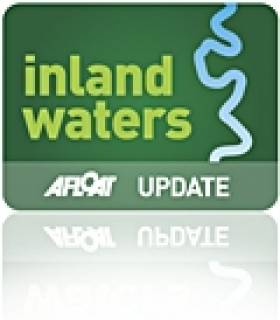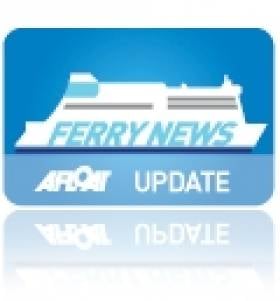Displaying items by tag: waterfront property
Cork Harbour Site On Market For Fraction Of 2016 Price
#CorkHarbour - Falling prices across prime Cork Harbour waterfront sites could be a boon for investors with serious plans in light of the Government's new marine focus.
As the Irish Examiner reports, the former Haulbowline Industries site at Passage West, which went for €25 million less than a decade ago, is now on the market for a fraction of that price.
It's expected that it will play a role alongside the busy Port of Cork, as will the 114-acre site at Marino Point directly across the harbour pinch point, for which a deal is being done for a similarly significant discount on its previous price tag.
Though previous ambitions for the Passage West site as a flagship €200-million marina development did not come to fruition, it remains centre of a thriving working port.
And with sales on smaller cites in Cork city proper reaching the eight-figure mark, it's the best time in years for marine-minded investments aiming to take advantage of Ireland's burgeoning 'Blue Economy'.
The Irish Examiner has more on the story HERE.
Lough Erne Resort Land Dispute To Be Settled
#WaterfrontProperty - A land dispute relating to the Lough Erne Resort golf course is expected to be resolved next month.
Last October reports confirmed the purchase of the five-star lakeside resort by American billionaire businessman Tony Saliba.
The deal came after much speculation that the Chicago-based 'market wizard' would snap up the site of the 2017 Irish Open.
Neither he nor any holding companies connected to him are involved in the proceedings issued against the former owners of the resort by a Roy Cathcart over a piece of land at the waterfront location, which the News Letter says have resulted in a confidential settlement.
And the High Court has heard that the legal action over the exclusive waterfront property – which hosted the G8 Summit in 2013 – will be resolved in early May.
The News Letter has more on the story HERE.
Cork Harbour Summer Home Has Nautical Style
#WaterfrontProperty - A modernised 1920s summer home on Cork Harbour is on the market for a cool €1.2 million.
But as the Irish Examiner reports, Tanglewood in Currabinny is worth every penny – and might well be a bargain to those with multiple millions to splash out on superyachts.
The house and grounds are deserved as "in better order, and – dare to say, more ship-shape – than ever in its almost 100 years of proud standing."
Its most recent makeover 15 years ago saw the addition of a new upper east wing with double guest accommodation furnished in a nautical style care of local yacht designer Rob Jacob.
Outside the grounds include a Japanese-styled garden, and a private gate into the local Coillte woods.
But the star attraction might well be its waterfront aspect, at an elevated site above Currabinny pier. The Irish Examiner has much more on this property HERE.
Elsewhere in Cork, a modest two-bed seaside home in nearby Myrtleville could be yours for €350,000.
Ceann Mhara – Head of the Sea – is "a peach by a beach", combining its shoreside setting with a sunny aspect and proximity to popular local swimming hoe Poulgorm, which it sits right above.
And its value is expected to rocket as the summer months approach, so any interested parties should take a look while they can! The Irish Examiner has more HERE.
For those with more majestic tastes, however, there's Ardfry House in Oranmore, as the Connacht Tribune reports.
This 16,700sqft detached period house with outbuildings and an orchard on more than 28 acres is an attraction in and of itself – it was the setting of Hollywood spy thriller The Mackintosh Man in the 1970s – and its quality reflected in the €2 million guide price.
But also on its grounds are the remains of a ninth-century moated castle with the best part of a kilometre of sea frontage on a peninsula in Galway Bay, opposite the world famous golf resort.
#WaterfrontProperty - If stunning yet tranquil views over Galway Bay to the Clare hills beyond appeal, an exclusive apartment development in Salthill might be your next home.
As the Galway Advertiser reports, all 12 apartments in Gentian Villas overlook the bay from an elevated site adjacent of Galway Golf Club and just a short walk from Salthill's famed promenade - and a stroll again into the heart of the City of the Tribes.
And extensive renovations inside the twi-bed owner-occupied home on offer make its guide price of €195,000 a real bargain for the quality of life you'll get from living there. The Advertiser has more HERE.
Meanwhile, for those in need of a little more room, this terraced home outside Schull in West Cork could be just the ticket.
7 The Coastguard not only comes with much sought-after sea views, but also use of a shared slipway at the private development - perfect for boat owners in what's one of the region's most popular cruising and racing destinations.
Picturesque Homes In Clare & Fermanagh Perfect For Anglers
#WaterfrontProperty - Two new properties on the market in Clare and Fermanagh are sure to appeal to keen anglers.
Sugarloaf on Clifden Hill in Co Clare overlooks Lake Inchiquin, described by the Irish Independent as an 'angler's paradise', and hosting a bounty of wildlife including the spectacular sea eagle.
But the picturesque spot is also a popular area for sunny-day picnics, and not only with the locals.
Sugarloaf provides a permanent picnic spot in the heart of that beautiful visa, with a detached three-bed home in 1.5 acres of gardens with panoramic views of the lake nearby and the Burren beyond.
And in spite of its privacy, with no neighbours in sight, you're just 3.5km from the village of Corofin and a swift drive further on to Ennis.
The Irish Independent has more on this property, on the market for €315,000.
North of the border, angling enthusiasts might be tempted by Amled's Fishing Lodge in Garrison, Co Fermanagh.
Within walking distance of Lough Melvin, the spacious detached five-bed home is on a secure site with high fencing, and plenty of room for boats and more in the driveway.
The wooded grounds have also been developed by the previous owner for wheelchair use, making garden maintenance easier than usual.
It's an unfinished renovation project - the upstairs is yet to be completed - but it'll be more than worth the effort to many, especially with an asking price of just £115,000 (€159,000). 4NI has more on this property.
Elsewhere, for those who just want to enjoy that seaside vibe, the Irish Independent sings the praises of Salthill in Galway.
Just a short walk from the centre of the City of the Tribes, the charming suburb maintains its own old-school seaside town atmosphere, with plenty of local social options, especially for dining.
And of course there's the renowned promenade, which hosts among others the annual An Tóstal race for Galway Hookers.
Victorian Country Home On The Banks Of The Blackwater
#WaterfrontProperty - The Irish Examiner reports on a new arrival to the waterfront property market in Woodville House, a unique country home on the banks of the River Blackwater in Co Cork.
With an asking price of €625,000, this five-bay Victorian home between Fermoy and Mallow may be large, but owner Dr Brendan Cousins remarks on its simple maintenance.
And the four-bed main house with a self-contained two-bed annex comes with all the modern conveniences you might expect, like central heating, as well as others that might surprise, such as washbasins in the bedrooms.
But the real attraction, besides the sheltered 11-acre grounds retaining many of the old stone walls of outbuildings, is surely the salmon fishing - with local angling club members allowed access on a rotational basis.
The Irish Examiner has much more on this property HERE.
Victorian Terrace With 'Finest' Views Over Belfast Lough
#WaterfrontProperty - Another month, another great waterfront property with commanding views of Belfast Lough on the market in the shape of 3 Carrisbrooke Terrace, as the News Letter reports.
Just under £300,000 is the asking price for this late Victorian terraced seaside home in Bangor, perched above the southern shore and boasting "arguably the finest views in North Down over Belfast Lough, the Long Hole and Irish Sea and Antrim coastline."
But aside from the views, the four-bed home comes with two reception rooms, including a first-floor drawing room, with sanded and varnished wood flooring throughout and its cornice ceilings among other preserved original features.
The News Letter has much more on this property HERE.
Historic 'Navigation House' To Be New Lagan Canal HQ
#InlandWaters - A dilapidated building on the Lagan Canal that once served as home for the waterway's manager will get a new lease of life as the headquarters of the Lagan Canal Trust.
As the Belfast Telegraph reports, Navigation House, built in 1866 at Lisburn's Union Locks, was sold off in the 1950s and more recently was slated for demolition.
But after a listing by then NI Environment Minister Alex Attwood in 2012, the property was acquired by the National Trust's Hearth Revolving Fund and leased to the Lagan Canal Trust, which has announced plans to once again make it the most important building on the canal.
It's hoped to host an interpretive centre in the house to educate visitors on the history of the canal and its importance to Northern Ireland.
And it may also become a focal point in opening the Lagan Navigation to the wider community through angling, canoeing, walking, cycling and other activities.
The Belfast Telegraph has more on the story HERE.
Views Over Belfast Lough From Holywood Four-Bed Family Home
#WaterfrontProperty - A spacious detached four-bed family home with views across Belfast Lough could be yours for less than €900,000.
The News Letter has all the details on 9 Whinney Hill at Holywood in Co Down, a modernised and renovated home with a bounty of four reception rooms on the ground floor.
Two of these open via french doors onto a large decking area with views of the Antrim Hills across the lough.
Other features include central gas coal fires in the dining room and adjoining living room, a jacuzzi-style bath in the master bedroom en-suite, and plenty of space for multiple cars to park out front.
The News Letters has much more on this property HERE.
Waterford Estuary’s Secret Little Island Hotel Ferry Is Up for Sale
#Island&FerrySale – The luxury Waterford Castle Hotel & Golf Resort on Little Island in Waterford Estuary, as previously reported is for sale, however this does not include the cable-ferry Loreley, which is to be sold separately, writes Jehan Ashmore.
Colliers International is seeking in excess of €4.5m for the secluded resort on the River Suir which also includes 48 self-catering garden lodges and clubhouse on the 310-acre island a mile downriver of Waterford City.
The property on Little Island is reached by the private 12-car capacity Loreley which is to be sold for €700,000. She operates between Grantstown and Little Island otherwise known locally as 'The Island'.
Asides this ferry, further downriver is another service, Passage East-Ballyhack in Co. Wexford. Arguably the Little Island ferry is the least known of operations to run on Irish estuaries and across rivers.
The service to Little Island takes a mere three-minute hop across King's Channel, a narrow disused shipping lane along the south side of the island. The other main channel is mostly used by yachts and visiting vessels to Waterford Marina, naval ships and cruiseships while commercial shipping is centred on Belview, a downriver terminal for the Port of Waterford along the banks of Co. Kilkenny.
Last year there was a dispute between the hotel owner and ferry contractor as reported on Afloat.ie over the running of the 1959 German built ferry that operates a round-the-clock service. For another closer-up photo of the ferry published in Ships Monthly, click HERE.
Loreley carries 57 passengers including foot-users, though the vast majority of traffic visiting the hotel and resort is taken is up by vehicles of the 12 car capacity deck. For ease of operations she has double-ended ramps.
It is understood that the first custom built vehicle-carrying ferry to ply the narrow channel was Verolme Cork Dockyard built ferry, Strongbow completed in 1968 and entered service the following year.
She was replaced by a ferry from Scandinavia, a 6-car carrying 24 passenger vessel renamed Little Island Ferry, however she too was displaced by a another Nordic ferry, Elvera, a former Swedish lake-ferry. She was introduced on the Waterford Estuary in 1999. Both she and her predecessors were chain-operated ferries.
The current 110 tonnes ferry originally named Loreley V, served as a River Rhine ferry between St. Goarshausen and St. Goar. She was sold to the Irish hotel and introduced in 2008. Unlike the previous chain-ferries, she is a self-propelled ferry which uses cable-wires to guide her across the river.
According to the Irish Times article, it was suggested that new owners of the property consider the feasibility of providing a bridge across the channel given much cheaper construction procedures have been devised.





































































